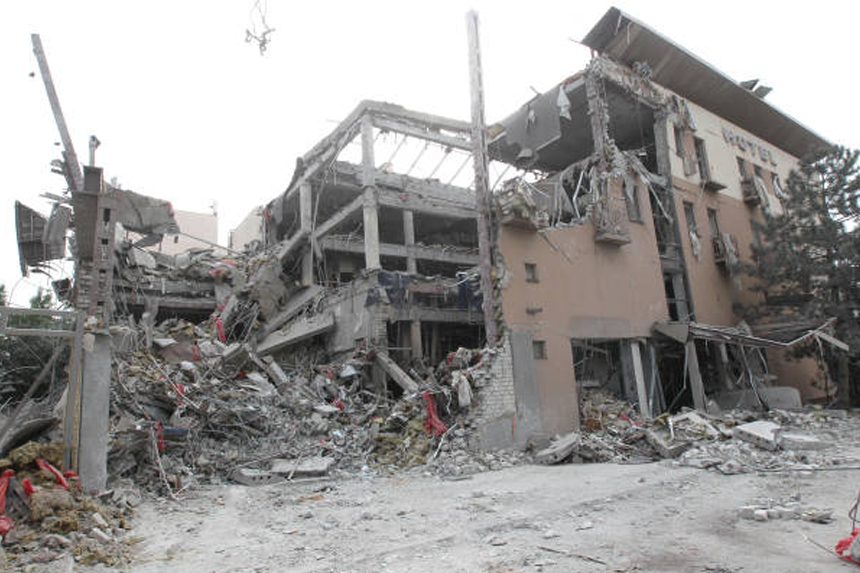With eighteen individuals dead—nine of them children—a fatal Kryvyi Rih missile strike begs serious concerns about Russia’s motivations during the current negotiations on a ceasefire. Close to the eastern front line, the central Ukrainian city has once more become a battlefield.
- What transpired Friday evening in Kryvyi Rih?
- Was the missile meant to land on civilians?
- What Does Russia Claim Regarding the Strike?
- Has Kryvyi Rih lately experienced any more attacks?
- Are Leaders Worldwide Reacting to the Escalation?
- What does this imply for prospects for Ceasefire?
- What then lies ahead for Ukraine and Kryvyi Rih?
What transpired Friday evening in Kryvyi Rih?
A Russian ballistic missile targeted a residential area in Kryvyi Rih, a metropolis of more than 600,000 people in central Ukraine, late Friday evening. Reportedly an Iskander-M armed missile with a cluster payload, it tore through civilian infrastructure, killing at least 18 people and injuring more than 40 others.
Nine children were among the casualties; pictures of a terrible scene—bodies lying near a playground—and a sizable portion of a 10-story home block devastated abound. Hospitals soon filled with the injured as emergency personnel hurried to evacuate survivors from the debris. Just three months old was the youngest victim hurt.
Born and bred in Kryvyi Rih, President Volodymyr Zelensky denounced the attack and voiced great sadness over the catastrophe. “There is only one reason why this continues: Russia does not want a ceasefire; we see this on social media,” he said on social media.
Since Russia’s full-scale invasion started in 2022, this Kryvyi Rih missile strike is regarded as one of the worst attacks on the city. It has raised global worries on civilian safety and the genuineness of continuous peace negotiations.
Was the missile meant to land on civilians?
Ukrainian officials are convinced that the strike was planned and meant to inflict the most possible civilian casualties. Head of the Dnipropetrovsk regional administration, Serhii Lysak, claims the missile exploded mid-air to boost its devastating radius. This is in line with the employment of a cluster warhead, an internationally divisive weapon outlawed by several nations.
Head of military defense for Kryvyi Rih, Oleksandr Vilkul, declared, “The missile exploded in the air… to injure more people.” Youngsters died on or close to a playground. His comments capture the intense resentment and sadness among neighbors and municipal leaders.
Later military announcements from Ukraine confirmed that there were no military targets in the vicinity, therefore supporting the assertion that the Kryvyi Rih missile assault was a deliberate attack on a residential area.
What Does Russia Claim Regarding the Strike?
Russia’s Defence Ministry issued a statement shortly following the incident, alleging that the missile had landed at a site used for meetings between Western military instructors and Ukrainian unit commanders. They said that up to 85 people perished. They offered no data, though, to bolster this claim.
Part of a larger Russian disinformation operation meant to deflect international criticism and evade responsibility, Ukrainian officials rejected the allegation as baseless. A military spokesman from Ukraine said, ” Russia is spreading false narratives to cover up its cynical crime.”
Many analysts and human rights watchers contend that these kinds of strikes—including the Kryvyi Rih missile strike—are being used to threaten the Ukrainian population and destabilize rear areas—even those far from the front lines.
Has Kryvyi Rih lately experienced any more attacks?
Indeed, Kryvyi Rih has now been singled out several times. Another missile strike in the city core earlier in the week claimed four lives. Kryvyi Rih was struck once on the same day Friday’s lethal missile impact—this time by a swarm of drones.
The drone attack reportedly set off at least four fires throughout the city. Once, a drone strike set her private house ablaze, and an old woman was burned alive on one occasion. At least five other persons suffered injuries throughout the city.
Though it is 70 kilometers from the present battle line, these repeated strikes expose a sad trend: Kryvyi Rih is progressively becoming the focal point for Russia’s attack on metropolitan civilian neighborhoods.
Are Leaders Worldwide Reacting to the Escalation?
Russia has been under increasing pressure from all around to de-escalate and take part in real truce negotiations. Top military officials from the UK and France visited President Zelensky in Kiev on the day of the Kryvyi Rih missile strike. Talks revolved around the possible deployment of foreign peacekeepers to enforce a ceasefire should one be attained.
Still, many Western officials are dubious of Russia’s motives. Speaking in Brussels during a NATO conference, UK Foreign Minister David Lammy said, “The Russian leader could accept a ceasefire now, [but] he continues to bombard Ukraine, its civilian population.”
Saying, “The Russians know the American position, and we will know from their answers very soon whether they are serious about peace or whether it is a delay tactic,” US Secretary of State Marco Rubio reflected same uncertainty.
These feelings mirror growing worry about Russia not dealing honestly. The story of peace gets more difficult to preserve with constant assaults like the Kryvyi Rih missile strike.
What does this imply for prospects for Ceasefire?
The violence in Kryvyi Rih, Kharkiv, and other places presents a dismal picture for the near future. Officials from Ukraine contend that ongoing attacks compromise the very basis for negotiations on a ceasefire. They think Russia is trying to get leverage by continuing to cause damage and terror.
Oleksandr Vilkul said straightforwardly: “There is no strategic justification for this attack. It is related to fear and suffering. He characterised the Kryvyi Rih missile strike as an act of fear rather than military necessity.
Ukraine’s public opinion has been more hardening as many demand more military support and a more robust worldwide response. The humanitarian cost keeps rising in the meantime.
What then lies ahead for Ukraine and Kryvyi Rih?
Apart from destroying a neighborhood, the Kryvyi Rih missile strike looms long over peace negotiations. Ukraine is once more left in mourning and ready for more strikes after innocent lives—many of them those of children- are lost.
Although diplomatic channels are still open, on the ground, behavior reveals a different picture. Hope for peace will remain brittle and dubious until the attacks end.




